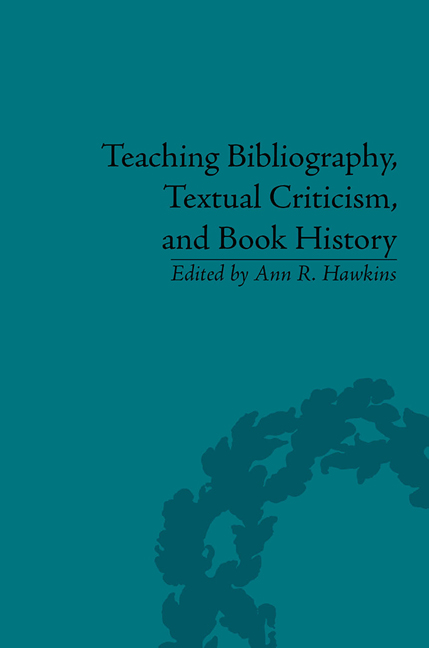Book contents
- Frontmatter
- Contents
- Notes on Contributors
- Foreword
- Introduction: Towards a pedagogy of Bibliography
- Part I Rationales
- Part II Creating and Using Resources
- Part III Methodologies
- Teaching ‘History of the Book’
- Teaching Bibliography and Research Methods
- The Bibliography and Research Course
- Integrating ‘Bibliography’ with ‘Literary Research’: A Comprehensive Approach
- The Hidden Lives of Books
- Learning from Binders: Investigating the Bookbinding Trade in Colonial Philadelphia
- Papermaking, History and Practice
- The Bibliographical Analysis of Antique Laid Paper: A Method
- Teaching Textual Criticism
- Part V Resources
- Index
The Bibliographical Analysis of Antique Laid Paper: A Method
from Teaching Bibliography and Research Methods
- Frontmatter
- Contents
- Notes on Contributors
- Foreword
- Introduction: Towards a pedagogy of Bibliography
- Part I Rationales
- Part II Creating and Using Resources
- Part III Methodologies
- Teaching ‘History of the Book’
- Teaching Bibliography and Research Methods
- The Bibliography and Research Course
- Integrating ‘Bibliography’ with ‘Literary Research’: A Comprehensive Approach
- The Hidden Lives of Books
- Learning from Binders: Investigating the Bookbinding Trade in Colonial Philadelphia
- Papermaking, History and Practice
- The Bibliographical Analysis of Antique Laid Paper: A Method
- Teaching Textual Criticism
- Part V Resources
- Index
Summary
Once students have been introduced to the history and practice of papermaking, they may become interested in ways scholars have used paper to solve bibliographic problems. A fine introduction to the subject is John Bidwell's ‘The Study of Paper as Evidence, Artefact, and Commodity’ where he observes that ‘By examining paper, scholars have detected literary forgeries, discovered misleading dates in early imprints, and reassembled manuscripts in their proper order after the original sequence had been disturbed’. My purpose here is to introduce a technique for the description and analysis of hand-made antique laid paper that is simple and effective enough to be widely accessible even to nascent filigranologists.
One of the earliest studies to show the importance of paper as bibliographical evidence is W. W. Greg's two-part essay ‘On Certain False Dates in Shakespearian Quartos’ (The Library, 1908). The Pavier quartos, so called for their publisher, are a group of ten plays attributed to Shakespeare which are occasionally found bound together and are variously dated 1600, 1608, and 1619. Having distinguished twenty-six different watermarks as well as some unmarked stock used to print these quartos, Greg found that in a number of instances paper bearing the same watermarks appeared in quartos with different title page dates. Understanding that hand-made printing paper was an industrial commodity produced on moulds whose lifespan was probably something on the order of a year to eighteen months, that paper was typically bought ad hoc by publishers and/or printers, and that stocks of paper were quickly consumed, Greg recognized that the earlier dates must be false.
- Type
- Chapter
- Information
- Teaching Bibliography, Textual Criticism, and Book History , pp. 149 - 154Publisher: Pickering & ChattoFirst published in: 2014



